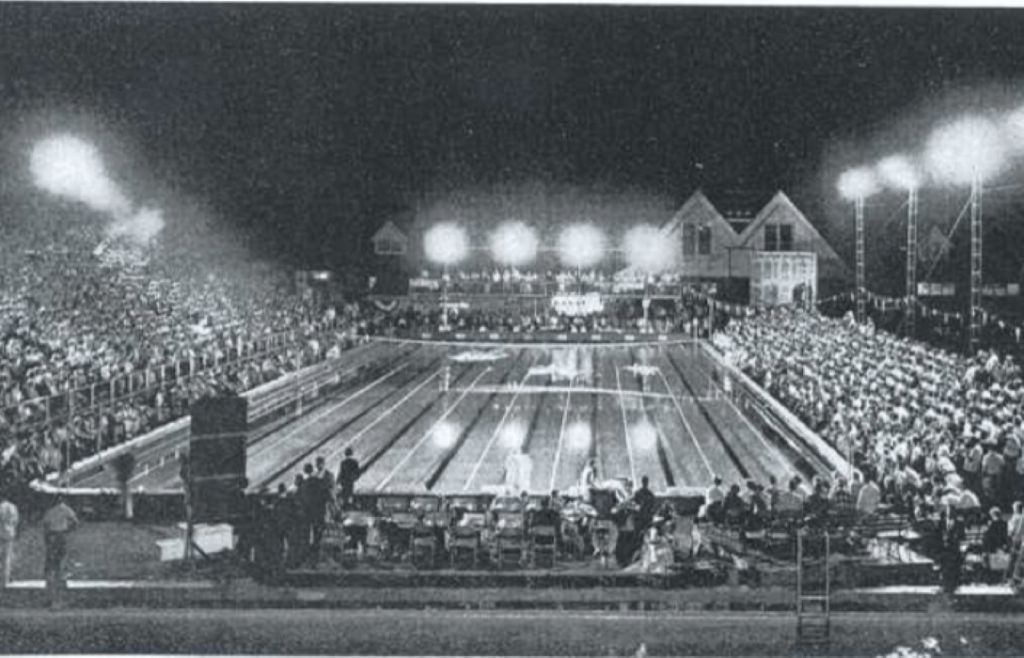A Look at Early U.S. Olympic Trials Development

In 2020, we’re missing out on one of the fastest and most exciting meets in the sport of swimming: The U.S. Olympic Trials. The history of this meet reveals an interesting progression of events as they were included in the Olympics, and gives insight into the history of the sport of swimming. Looking into the trials in the early 1900s unveils the development of new strokes, a broader program and faster times. A comparison of the Olympic Trials of 1920, 1936 and 1956 indicates significant growth, from organizational and competitive standpoints.
The first U.S. Olympic Trials were held in 1920, and in a split format. The men competed in Lincoln Park Lagoon in Chicago, Illinois, while the women raced in Manhattan Beach, New York. The women only had two individual events, both freestyle, while the men had six individual events that included freestyle, backstroke and breaststroke. Ethelda Bleibtrey not only performed well at these Trials, she went on to win Olympic gold in each of her events at the 1920 Olympics in Antwerp.
1920 Event Winners
Women
100 freestyle: Ethelda Bleibtrey (time not listed in results)
300 freestyle: Ethelda Bleibtrey (4:34.2)
Men
100 freestyle: Duke Kahanamoku (55.0)
400 freestyle: Ludy Langer (5:22.0)
1500 freestyle: E.T. Bolden (25:26.0)
100 backstroke: Ray Kegeris (1:22.6)
200 breaststroke: Lt. M.J. McDermott (3:14.0)
400 breaststroke: G.A. Taylor (7:00.4)
Sixteen years later, in 1936, the Trials were still held separately by gender, with the men in Providence, Rhode Island, and the women in Long Island, New York. The only difference in events by gender was the addition of the 1500 meter freestyle to the men’s list of events. The 2020 (2021) Olympics are set to have a women’s 1500 meter freestyle for the first time, with the men adding an 800 freestyle and the programs fully matching. The 1936 Trials had heats and finals for every event, except the 1500.
In addition to athletic development, times were a lot faster at Trials due in part to new silk suits introduced by Speedo that had seen widespread use leading up to and at this meet. The racing suit for women was the first of its kind that exposed the shoulder blades, and was meant to fit the exact body shape of the swimmer. Meanwhile, men were allowed to wear bare-chest suits for the first time.
1936 Event Winners
Women
100 freestyle: Katherine Rawls (1:11.1)
400 freestyle: Lenore Kight Wingard (5:36.9)
100 backstroke: Eleanor Holm Jarret (1:19.3)
200 breaststroke: Dorothy Schiller (3:14.9)
Men
100 freestyle: Arthur Highland (58.8)
400 freestyle: Ralph D. Flanagan (4:47.8)
1500 freestyle: Ralph D. Flanagan (19:37.8)
100 backstroke: Adolph Kiefer (1:07.5)
200 breaststroke: John H. Higgins (2:44.1)
The 1956 Trials featured an increase in the number of events from 1936, as butterfly was contested separately from breaststroke for the first time. When swimmers began to realize that bringing both arms out of the water for recovery in breaststroke would be faster, it was deemed illegal. However, the move led to the formation of the butterfly stroke. Times continued to drop, partially due to how Speedo began using nylon in 1956, giving the suits a more lightweight and elastic feel.
1956 Event Winners
Women
100 freestyle: Nancy Simmons (1:05.1)
400 freestyle: Sylvia Ruuska (5:10.0)
100 butterfly: Shelley Mann (1:12.3)
100 backstroke: Carin Cone (1:15.0)
200 breaststroke: Mary Jane Sears (2:58.6)
Men
100 meter freestyle: William Woolsey (57.0)
200 meter freestyle: Ford Konno (2:10.6)
400 meter freestyle: George Breen (4:33.1)
1500 meter freestyle: George Breen (18:13.7)
100 meter backstroke: Yoshi Oyakawa (1:05.2)
200 meter breaststroke: Robert Hughes (2:44.4)
200 meter butterfly: William Yorzyk (2:19.0)
A lot has changed since the first half of the 1900s. Swimmers wear newly developed racing suits, meant to repel water and allow for higher efficiency within the stroke. Backstrokers do not have to touch the wall for turns while on their back and breaststrokers are allowed a dolphin kick off the start and turns. As a reference point for how the top times at Trials have changed, here are some results from the 2016 meet.
2016 Event Winners (Only events from 1956, for comparison)
Women
100 freestyle: Abbey Weitzeil (53.28)
400 freestyle: Katie Ledecky (3:58.98)
100 butterfly: Kelsi Worrell (56.48)
100 backstroke: Olivia Smoliga (59.02)
200 breaststroke: Lilly King (2:24.08)
Men
100 freestyle: Nathan Adrian (47.72)
200 freestyle: Townley Haas (1:45.66)
400 freestyle: Connor Jaeger (3:43.79)
1500 freestyle: Connor Jaeger (14:47.61)
100 backstroke: Ryan Murphy (52.26)
200 breaststroke: Josh Prenot (2:07.17)
200 butterfly: Michael Phelps (1:54.84)
Reflecting on the U.S. Olympic Trials from the early and mid 1900s shows abundant growth in the sport. More efficient technique and improved equipment, such as caps, goggles, and special racing suits, have generated significantly faster times. In addition, the development of different events shows a more equal competition for both men and women.
Next year, the top swimmers in this country will make more history, and an extra year of anticipation has made us, as spectators, more excited to watch.




Loved this article! So informative and insightful.